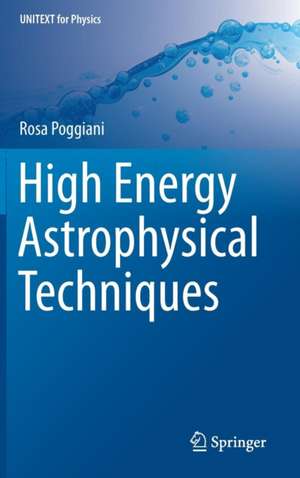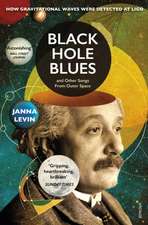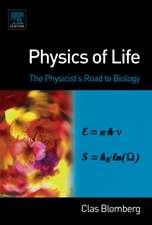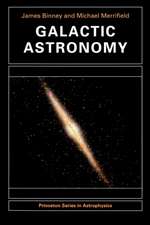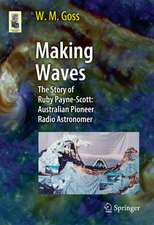High Energy Astrophysical Techniques: UNITEXT for Physics
Autor Rosa Poggianien Limba Engleză Hardback – 15 dec 2016
The purpose of the book is to bridge the gap between the reference books and the specialized literature. For each type of astronomy, the discussion proceeds from the orders of magnitude for observable quantities. The physical principles of photon and particle detectors are then addressed, and the specific telescopes and combinations of detectors, presented.
Finally the instruments and their limits are discussed with a view to assisting readers in the planning and execution of observations.
Astronomical observations with high-energy photons and particles represent the newest additions to multimessenger astronomy and this book will be of value to all with an interest in the field.
| Toate formatele și edițiile | Preț | Express |
|---|---|---|
| Paperback (1) | 493.56 lei 6-8 săpt. | |
| Springer International Publishing – 4 iul 2018 | 493.56 lei 6-8 săpt. | |
| Hardback (1) | 499.77 lei 6-8 săpt. | |
| Springer International Publishing – 15 dec 2016 | 499.77 lei 6-8 săpt. |
Din seria UNITEXT for Physics
- 15%
 Preț: 534.17 lei
Preț: 534.17 lei - 17%
 Preț: 459.62 lei
Preț: 459.62 lei -
 Preț: 351.06 lei
Preț: 351.06 lei - 15%
 Preț: 603.83 lei
Preț: 603.83 lei - 19%
 Preț: 470.37 lei
Preț: 470.37 lei -
 Preț: 358.20 lei
Preț: 358.20 lei -
 Preț: 426.23 lei
Preț: 426.23 lei -
 Preț: 357.86 lei
Preț: 357.86 lei -
 Preț: 358.00 lei
Preț: 358.00 lei - 15%
 Preț: 582.95 lei
Preț: 582.95 lei -
 Preț: 489.87 lei
Preț: 489.87 lei - 17%
 Preț: 362.51 lei
Preț: 362.51 lei - 17%
 Preț: 395.01 lei
Preț: 395.01 lei - 17%
 Preț: 493.74 lei
Preț: 493.74 lei - 13%
 Preț: 355.10 lei
Preț: 355.10 lei - 17%
 Preț: 368.41 lei
Preț: 368.41 lei - 17%
 Preț: 395.64 lei
Preț: 395.64 lei -
 Preț: 458.61 lei
Preț: 458.61 lei - 15%
 Preț: 474.31 lei
Preț: 474.31 lei -
 Preț: 456.66 lei
Preț: 456.66 lei -
 Preț: 404.13 lei
Preț: 404.13 lei -
 Preț: 327.48 lei
Preț: 327.48 lei -
 Preț: 453.39 lei
Preț: 453.39 lei -
 Preț: 491.21 lei
Preț: 491.21 lei -
 Preț: 828.92 lei
Preț: 828.92 lei -
 Preț: 724.07 lei
Preț: 724.07 lei -
 Preț: 489.30 lei
Preț: 489.30 lei - 15%
 Preț: 509.74 lei
Preț: 509.74 lei - 15%
 Preț: 528.63 lei
Preț: 528.63 lei - 15%
 Preț: 511.05 lei
Preț: 511.05 lei - 18%
 Preț: 796.13 lei
Preț: 796.13 lei - 15%
 Preț: 782.69 lei
Preț: 782.69 lei - 15%
 Preț: 597.20 lei
Preț: 597.20 lei - 15%
 Preț: 667.20 lei
Preț: 667.20 lei -
 Preț: 351.06 lei
Preț: 351.06 lei -
 Preț: 387.96 lei
Preț: 387.96 lei -
 Preț: 395.85 lei
Preț: 395.85 lei -
 Preț: 338.43 lei
Preț: 338.43 lei -
 Preț: 399.88 lei
Preț: 399.88 lei - 15%
 Preț: 543.67 lei
Preț: 543.67 lei
Preț: 499.77 lei
Preț vechi: 587.96 lei
-15% Nou
Puncte Express: 750
Preț estimativ în valută:
95.63€ • 100.11$ • 79.13£
95.63€ • 100.11$ • 79.13£
Carte tipărită la comandă
Livrare economică 05-19 aprilie
Preluare comenzi: 021 569.72.76
Specificații
ISBN-13: 9783319447285
ISBN-10: 3319447289
Pagini: 167
Ilustrații: XIV, 163 p. 64 illus.
Dimensiuni: 155 x 235 x 11 mm
Greutate: 0.43 kg
Ediția:1st ed. 2017
Editura: Springer International Publishing
Colecția Springer
Seria UNITEXT for Physics
Locul publicării:Cham, Switzerland
ISBN-10: 3319447289
Pagini: 167
Ilustrații: XIV, 163 p. 64 illus.
Dimensiuni: 155 x 235 x 11 mm
Greutate: 0.43 kg
Ediția:1st ed. 2017
Editura: Springer International Publishing
Colecția Springer
Seria UNITEXT for Physics
Locul publicării:Cham, Switzerland
Cuprins
Part 1: The basics.- Chapter 1: Setting the scene: high energy photons and particles.- Chapter 2: Radiation-matter interactions.- Chapter 3: Interactions of photons and particles along the path.- Part 2: The world of detectors.- Chapter 4: Detectors: general characteristics.- Chapter 5: Detectors bases on ionization in gases and liquids.- Chapter 6: Scintillation detector systems.- Chapter 7: Detectors based on ionization in solid state materials.- Chapter 8: Cherenkov and Transition Radiation detectors.- Chapter 9: Calorimeters.- Chapter 10: Measurement of physical properties of photons and particles.- Part 3: High energy astronomy.- Chapter 11: Ultraviolet and X-ray astronomy.- Chapter 12: Gamma ray astronomy.- Chapter 13: Cosmic ray astronomy.- Chapter 14: Neutrino astronomy.- Chapter 15: Gravitational wave astronomy.- Chapter 16: The dark side of the Universe.- Chapter 17: Observing in high energy astrophysics.- Chapter 18: Conclusions.
Recenzii
“This remarkable book is the attempt of covering not only the classical realm of high-energy astrophysics, but also the relatively new (or relatively less known) fields of the gravitational waves and of the problems and the perspectives connected with the detection of dark matter and dark energy. … A book for observational astronomers and highly recommended for university courses as well as the interested professionals.” (Alberto Vecchiato, Astrocom et al., astrocometal.blogspot.de, February, 2016)
Notă biografică
Rosa Poggiani graduated in Physics from the University of Pisa, Italy, in 1988. Her work has focused especially on the gravitational acceleration of antimatter probes, the detection of gravitational waves with interferometers, and the optical properties of astrophysical compact objects. She has made significant contributions to the physics of low-energy antimatter, suspension systems, high-vacuum compatibility and the cryogenic design of interferometric gravitational wave detectors, the optical spectroscopy of novae and the microvariability of blazars. Dr. Poggiani has been an investigator in a number of research projects and has been involved in various international collaborations. She was Coordinator of Control and DAQ for the P118T experiment on antiproton deceleration and trapping at CERN. She has been a member of the Virgo Collaboration for the interferometric detection of gravitational waves since 1993, and was the Coordinator of the last stage of the suspensions and ofthe vacuum compatibility of the suspension components. The LIGO and Virgo members were awarded the Special Breakthrough Prize In Fundamental Physics and the 2016 Gruber Cosmology Prize for the detection of gravitational waves.
Textul de pe ultima copertă
This textbook presents ultraviolet and X-ray astronomy, gamma-ray astronomy, cosmic ray astronomy, neutrino astronomy, and gravitational wave astronomy as distinct research areas, focusing on the astrophysics targets and the requirements with respect to instrumentation and observation methods.
The purpose of the book is to bridge the gap between the reference books and the specialized literature. For each type of astronomy, the discussion proceeds from the orders of magnitude for observable quantities. The physical principles of photon and particle detectors are then addressed, and the specific telescopes and combinations of detectors, presented.
Finally the instruments and their limits are discussed with a view to assisting readers in the planning and execution of observations.
Astronomical observations with high-energy photons and particles represent the newest additions to multimessenger astronomy and this book will be of value to all with an interest in the field.
The purpose of the book is to bridge the gap between the reference books and the specialized literature. For each type of astronomy, the discussion proceeds from the orders of magnitude for observable quantities. The physical principles of photon and particle detectors are then addressed, and the specific telescopes and combinations of detectors, presented.
Finally the instruments and their limits are discussed with a view to assisting readers in the planning and execution of observations.
Astronomical observations with high-energy photons and particles represent the newest additions to multimessenger astronomy and this book will be of value to all with an interest in the field.
Caracteristici
Approaches the different types of high-energy observational astronomy as distinct research areas Provides state of the art information on instrumentation and observation planning and techniques Bridges the gap between reference books and the specialized literature Offers a combined approach to experimental and observational aspects Contains worked examples and set of exercises Includes supplementary material: sn.pub/extras
